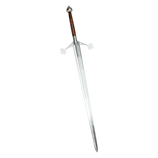- Description/Features
- Reviews
- Shipping and Returns
Description/Features
Important Note: This item is special ordered directly from the manufacturer and lead time may vary but usually is 2-4 weeks. Please contact us if you need this by a certain date, otherwise please allow ample lead time for delivery. We will reach out if the estimated time is longer. Thank you!
Scottish Claymore,
National Museum of Scotland.
The two-handed highland Claymore, or "claidheamh mor" in Scottish Gaelic, was one of the final developments of the distinctive Scottish sword. By the 16th century, the single-handed Scottish sword with its down-turned quillons had evolved not just into a basket-hilted variety of the same blade, but also a long, two-handed sword with an unique quatrefoil guard.
The Claymore was an aggressive infantry weapon. Too large to use on horseback or with a shield. It delivered overpowering blows that would sweep aside any efforts to block or parry. For over two hundred years, the Claymore witnessed inter-clan rivalries and used in wars against the English crown until the Battle of Killiecrankie in 1689.
Based on a early 16th century Claymore, the sword is gracefully engineered as a tough high-impact, yet impressively balanced weapon. The quaterfoil quillons are carefully crafted from originals on display in the Scottish National Museum, the British Museum, The Royal Ontario Museum and The Royal Armouries (Leeds). The blade, specifically designed to deliver devastating strikes, is elegant in its simplicity. The Claymore is a weapon evocative of the Scottish highlands, and the fierce clansmen who lived, fought, and died there.
Blade: 5160 High Carbon Steel. Dual Tempered HRc 60
48-50 at the core
Total length: 48"
Blade length: 37"
Blade width: 2"
Weight: 3 lbs 6 oz.
Blade thickness: 1.88 mm
POB: 5"
Scottish Claymore,
National Museum of Scotland.
The two-handed highland Claymore, or "claidheamh mor" in Scottish Gaelic, was one of the final developments of the distinctive Scottish sword. By the 16th century, the single-handed Scottish sword with its down-turned quillons had evolved not just into a basket-hilted variety of the same blade, but also a long, two-handed sword with an unique quatrefoil guard.
The Claymore was an aggressive infantry weapon. Too large to use on horseback or with a shield. It delivered overpowering blows that would sweep aside any efforts to block or parry. For over two hundred years, the Claymore witnessed inter-clan rivalries and used in wars against the English crown until the Battle of Killiecrankie in 1689.
Based on a early 16th century Claymore, the sword is gracefully engineered as a tough high-impact, yet impressively balanced weapon. The quaterfoil quillons are carefully crafted from originals on display in the Scottish National Museum, the British Museum, The Royal Ontario Museum and The Royal Armouries (Leeds). The blade, specifically designed to deliver devastating strikes, is elegant in its simplicity. The Claymore is a weapon evocative of the Scottish highlands, and the fierce clansmen who lived, fought, and died there.
Blade: 5160 High Carbon Steel. Dual Tempered HRc 60
48-50 at the core
Total length: 48"
Blade length: 37"
Blade width: 2"
Weight: 3 lbs 6 oz.
Blade thickness: 1.88 mm
POB: 5"
Reviews
We're currently collecting product reviews for this item. In the meantime, here are some reviews from our past customers sharing their overall shopping experience.
4.7
Out of 5.0

Overall Rating
94%
of customers that buyfrom this merchant give
them a 4 or 5-Star rating.
April 21, 2025 by Xena B. (Nebraska, United States)
“It was nice to get such a great discount on a big dance sword! Shipping is a touch high but it arrived so quickly it's genuinely worth it! It's a beautiful sword and perfectly balanced.”
Merchant Choice
They had pretty swords I really wanted.
Product Choice
I'm a Burlesque dancer, looking to add something interesting to my weapon arsenal.
March 2, 2025 by Skyler F. (United States)
“It is a good website.”
February 17, 2025 by A Reviewer (United States)
“Fine”
Merchant Choice
Had what I was looking for.
Shipping and Returns
This item is shipped directly from Canada. Shipping costs are automatically caluculated in the $30-40 range. Please allow 4-7 business days for delivery once shipped. This item cannot be expedited and is shipped by ground only.
Returns are only accepted for an exchange on this product. No returns for refunds are allowed, but returns for exchanges only for other Dark Sword products. Defective items from workmanship will be replaced free of charge. Thank you.
Returns are only accepted for an exchange on this product. No returns for refunds are allowed, but returns for exchanges only for other Dark Sword products. Defective items from workmanship will be replaced free of charge. Thank you.







